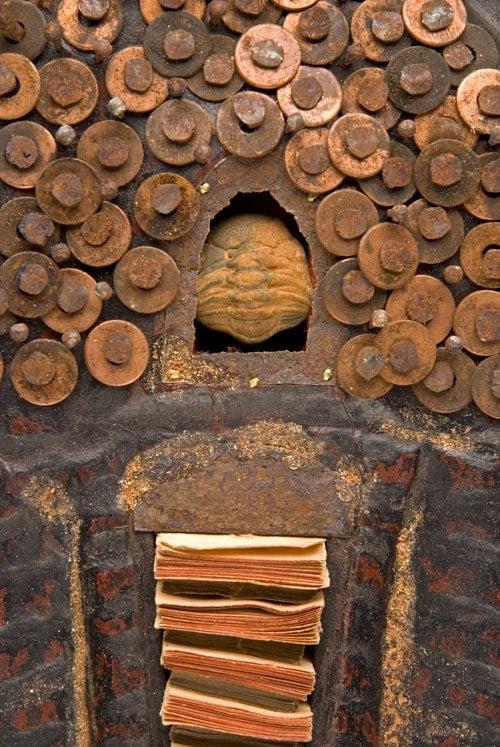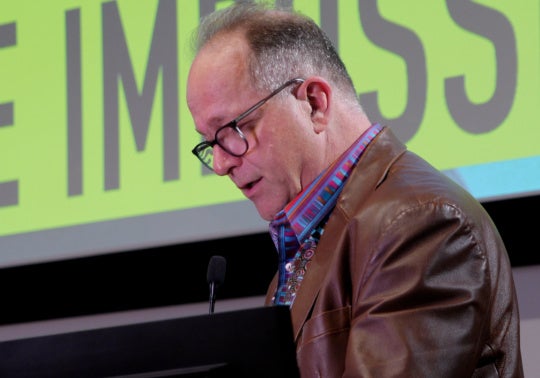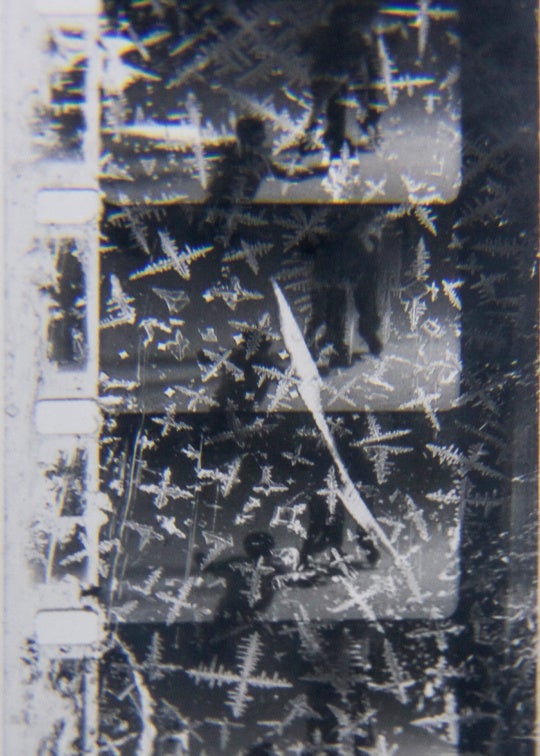
There’s been a recent boom of television production in Atlanta recently, but none quite like Alexis Hudgins’s Reality Show, a performance and exhibition recently filmed at {Poem 88} over the past few weeks (August 4-18, 2012). Hudgins, a Los Angeles-based artist and recent MFA graduate from UCLA, was collaboratively paired with her subject, artist and Georgia State University new media professor Stewart Ziff, by {Poem 88} director Robin Bernat.
Everyone still wants 15 minutes of fame, right? Not so, according to Ziff, who struggled with self-reflexivity and creative anxiety over the course of the entire project as an artist-turned-reality-TV subject. Throughout 10 days, the gallery was monitored 24/7, and in true Truman Show fashion, while Ziff was present during gallery hours for his artist residency-cum-panoptic experiment, all cameras were focused on him.


The gallery was temporarily transformed into a light version of a reality television set. As a whole, the exhibition would have benefited from a total gallery takeover, becoming a spectacle heightened to the level of an immersive installation (yet understandably more demanding of time and resources). Ziff was provided with space to use as his working area, and a confessional-style interview area was informally demarcated by moving blankets operating as a rug and including pink plastic chairs facing each other. On the other side of the gallery, an L-shaped wall was constructed to conceal the production room where Hudgins sat watching seemingly endless surveillance footage and diligently keeping field notes (subsequently bound in a book and to be later published as part of a larger document). Such notes reveal the infamous dramatization of the mundane inherent to the reality TV genre—take for example, “16:12 pm, Stewart continues drawing on the board and takes another bite of his burger,” or “12:00 pm, Day two in the gallery, Robin sits at her desk on her computer, we wait for Stewart to arrive”—and also Hudgins’s long professional experience working for reality television programs in Los Angeles.
Perhaps most successfully operating as a case study in collaboration and how individual personalities can affect group dynamics, these notes and surveillance footage provide insights not only into Ziff’s experience and working process, but also Robin Bernat and the gallery’s daily business. Hudgins, as producer, is thereby afforded emotional distance to translate such subjective experiences into formalized documents and footage.

Additionally, instead of the traditional interviews that supplement a reality program’s daily drama (usually conducted by one of the show’s producers), Hudgins alternatively opted for a local psychiatrist, Dr. Rosalind Mance, to interview Ziff periodically throughout the project. Hudgins, who originally studied psychology at Emory, believes that reality TV offers a situation that is no longer considered ethical within the psych world. This added context helps to transcend the basic conversation about the TV genre.
Ziff installed certain elements, or “props,” from his studio into the gallery in order to facilitate his temporary and (perhaps) forced art-making. Ziff initially installed an oversize chalkboard to brainstorm lists and make preliminary, temporary sketches. A worktable complete with a computer, a printer, and a large archive of photographs were present early on (Ziff was working through how to print a photograph two-dimensionally and then cut and mount it as a three-dimensional object). But later, towards the end of the show’s run, this equipment was removed and replaced with some of his former works and an even larger and quite impressive archive from his youth, consisting of NASA photographs, vintage Science magazines, geologic maps, and specific atlases of the moon, among other things.

During a fretful moment in one “episode,” Ziff confessed to Dr. Mance that he felt an overwhelming performance anxiety to produce a completed artwork at the end of the project’s duration. This conversation became a continuing thread and source of therapy for Ziff; once the experience became more participatory and less performative (in his mind), his viewpoint shifted, and it seemed to resolve itself by the end. Perhaps Ziff realized the process was product.
In reality TV programming, normally these confessional interviews serve as private moments to reflect on the day’s events (the “reality show”). Ziff is not allowed this luxury, however, and thus must compose these moments publicly with a psychiatrist and a palpable audience of gallery visitors watching his every move, glance, and nervous laugh. Instant gratification and passive voyeurism, which service the viewer so richly in reality TV, does carry over into these therapy interview sessions, yet because the viewer is also live and present, you can feel conversely exposed by taking part in this constructed economy of exchange.
Reality Show quite successfully drew attention to an artist’s studio practice and the anxiety that can accompany the private becoming public. And what evolves from a studio practice without the studio? As maybe Hudgins suggests, it becomes a theatre—artist as actor can now maneuver with said props, stage, set, and lights. And if Ziff functions now as actor, how can we determine authentic reality? Reality Show offers an opportunity to think on this question. Representation is always subjective, and Ziff’s authenticity (to himself, to his actor persona, to the project), and the blurring between true reality and the constructed representation of reality, are positively called into question through Hudgins’s pervasive lenses.
Click here to view more photographs by John Ramspott documenting Reality Show posted to BURNAWAY’s Flickr account.
{Poem 88} opens their fall programming with 1961, a solo exhibition of Nikita Gale’s photographic series created while in residence at The Center for Photography at Woodstock in Woodstock, New York, on view September 7-October 13, 2012.




